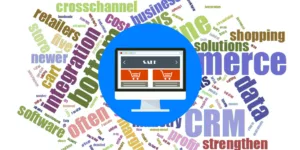When all is said and done, everything comes down to your bottom line in business. What you are taking in against your cost of operation and goods results in your profit or loss. This very simple form of math helps us know what’s working and what’s not.
In e-commerce, a $2 trillion industry according to Inddist, the profit margins tend to be thinner than they are in brick and mortar retail. Since the cost of shipping, fulfillment, inventory management, returns, back office, labor and marketing have to be factored in, margins are often razor thin.
Getting your bottom line to a healthier position requires hard work and dedication in this industry. Often, people rely on tools to automate the legwork of the tedious, most monotonous tasks while streamlining accuracy and efficiency along the way. Newer ecommerce CRM solutions are helping online retailers strengthen their bottom line in a number of ways. Here are five reasons to consider adding them to your SaaS (Software as a Service) lineup.
Cross-Channel Integration
Running an online store often means that you have an omni-channel presence. For example, a business that hosts their store through a shopping cart provider and their own URL likely is also selling on eBay, Amazon and other venues, like Newegg for tech or even Esty for handmade, artisan goods. The unfortunate aspect of this is that none of these channels really talk to each other or share data.
The good news is that newer e-commerce CRM solutions tether this data with cross-channel integration (you connect each sales channel to your CRM software and it pulls the data via API integration from the shopping cart or marketplace). This allows you to generate detailed charts that are fed with real-time data.
Having access to this data, as well as the instant customer profiles these systems generate, gives you the ability to better understand your customers, improve service and creating revenue-generating campaigns that benefit your bottom line.
Identifying Sales Trends
With access to cross-channel sales data, as well as customer specific data, you’ll have all the weapons that you need in your arsenal to succeed. For instance, you could look at your cross-channel seasonal sales history and learn that certain products become very trendy around July, when most people start their holiday shopping rush. Using this data, you could then create sales campaigns that you run during “hot” times of the year to put add some fat to your bottom line.
Another example includes using customer specific data to create newsletters or advertising campaigns that will generate the largest amount of revenue. For example, you could choose to market to select users during “hot” periods, but create an organic email marketing list that excludes serial returners – which would result in more sales, fewer returns, better reviews and an improved store ranking on marketplaces, not to mention positive social chatter as well as other innate benefits.
Reducing Impact of Returns
Speaking of returns, they can really eat into your bottom line. Recent studies by UPS have confirmed that 80% of consumers won’t buy from stores that don’t offer a no-questions-asked returns policy. But, related studies have also found that about 33% of all products ordered online are returned by consumers. Primary reasons include: Damaged product received; product different than online appearance; wrong product shipped; apparel does not fit.
Newer e-commerce CRM systems also feature returns management integrations. These not only streamline returns and reduce labor costs, helping you feed your bottom line, but also let you know the reason for returns. Using this data, you can make small changes to your return policy and even to your inventory, to reduce returns and improve customer loyalty and retention, while also padding your profits in the process.
Lowering Shipping Costs
Shipping cost is easily one of the biggest factors of any online retailer’s bottom line. With newer rate tiers being offered by USPS, and with discount providers like Stamps.com or Endicia to choose from, you can reduce your shipping costs exponentially by being smart about what discount shipping options you offer to customers.
E-commerce CRM can feed you this data, letting you know what the most popular shipping preferences are for each customer. Surveys have concurred that consumers are happy to wait for ground shipping, provided that the rate is fair. Using the cross-channel data from your CRM, you’d be able to not only forecast your shipping costs and packaging supplies expenditures in advance of your busy season, but you’d also be able to implement cost-saving methods beforehand, too.
Improving Customer Loyalty, Retention
CRM is all about enhancing the customer relationship. It’s a powerful customer service tool that shouldn’t be overlooked. Giving your team the ability to pull up a customer’s information, complete with ship status, order history and returns information, also provides them with the tools they need to resolve disputes and to deliver an exceptional level of service that helps improve retention and loyalty.
Keeping your bottom line in check is one thing. Fattening it up is quite another. CRM for e-commerce is a smart approach to online retailing. It gives you the power of data. Using this power, you’ll be able to improve your bottom line like never before.








